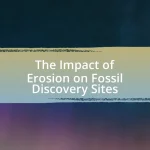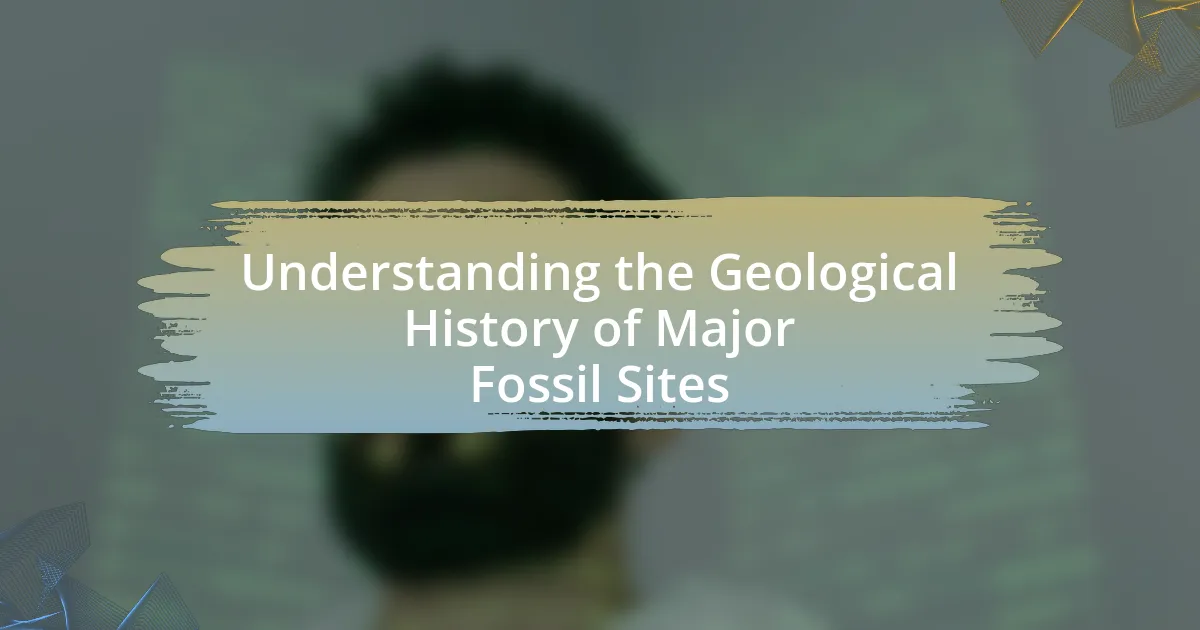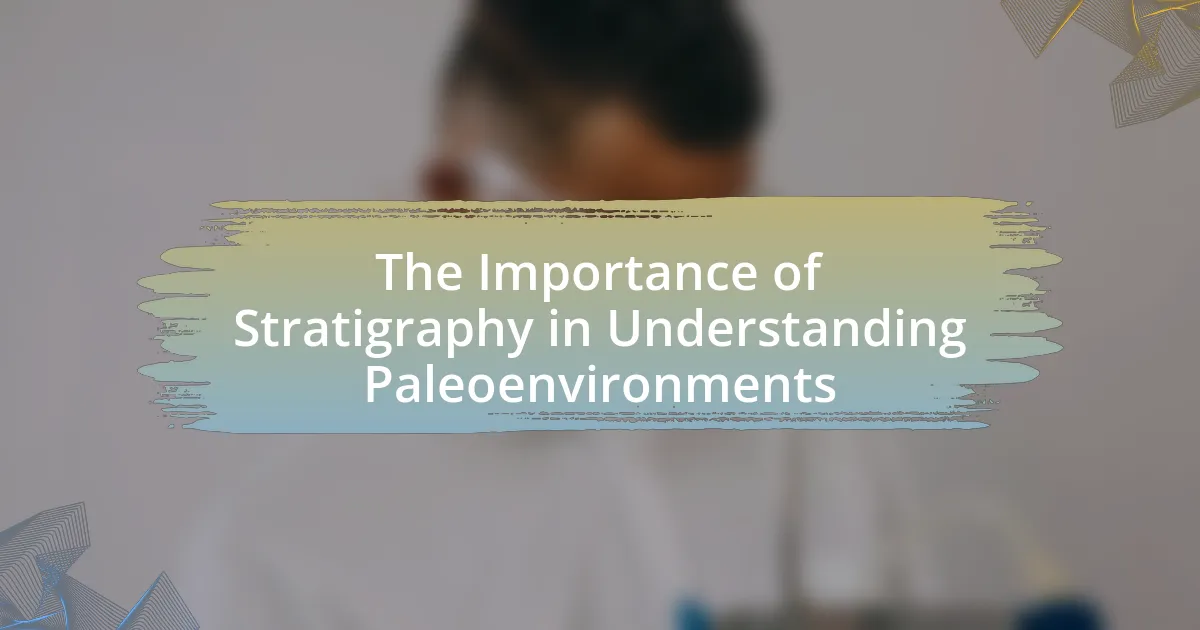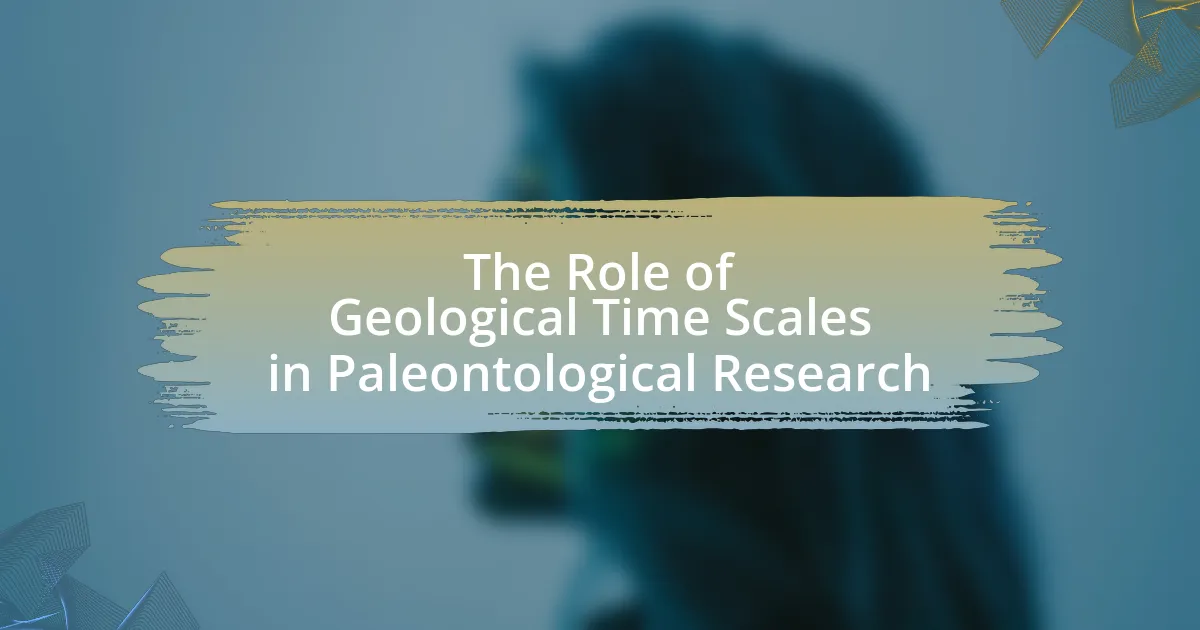The article explores the critical relationship between mineral composition and the fossilization process, emphasizing how minerals in the surrounding environment influence the preservation of organic remains. It details various fossilization processes, including permineralization and replacement, highlighting the roles of minerals such as silica, calcite, and iron in these processes. Additionally, the article discusses how environmental factors, sediment types, and diagenesis affect mineral composition and fossil integrity over time. Practical methods for analyzing mineral composition in fossils, such as X-ray diffraction and scanning electron microscopy, are also examined, providing insights into the conditions that facilitate fossilization and the implications for understanding ancient ecosystems.
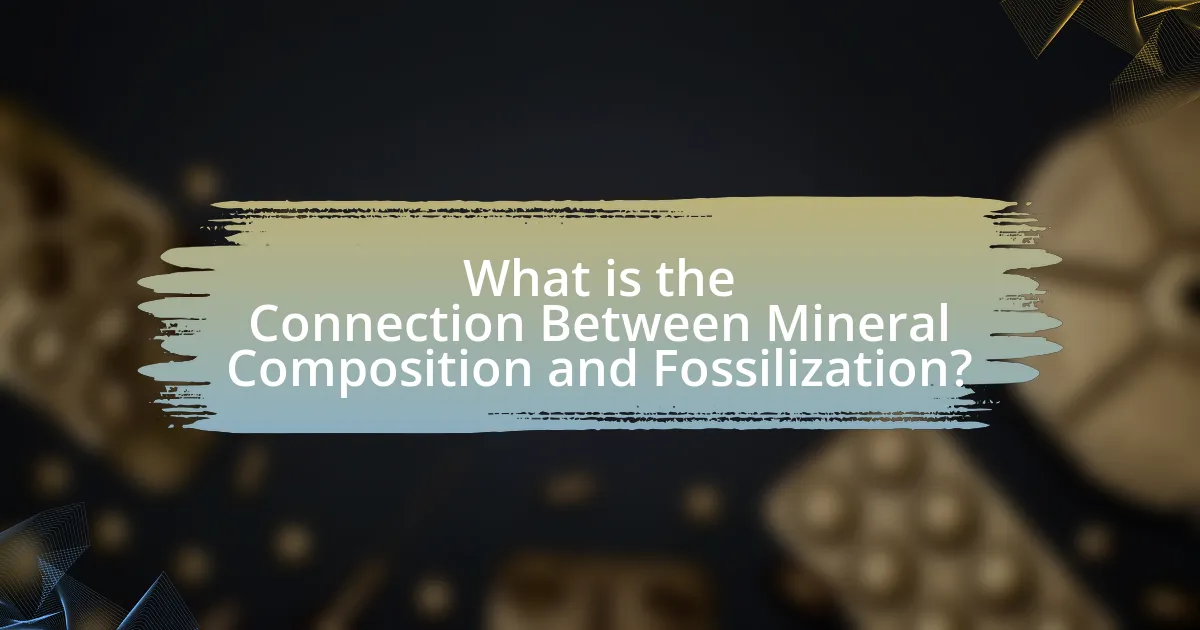
What is the Connection Between Mineral Composition and Fossilization?
The connection between mineral composition and fossilization lies in the fact that the minerals present in the surrounding environment influence the preservation of organic remains. Fossilization often occurs through processes such as permineralization, where minerals like silica, calcite, or iron replace organic material, effectively turning it into stone. For instance, studies show that the mineral content of sediment can dictate the rate and type of fossilization, with environments rich in calcium carbonate favoring the preservation of shells and skeletal remains. This relationship is crucial because it determines the quality and type of fossils that can be formed, impacting our understanding of past life forms and ecosystems.
How do minerals influence the fossilization process?
Minerals significantly influence the fossilization process by facilitating the replacement of organic materials with inorganic substances. During fossilization, minerals such as silica, calcite, and iron can infiltrate the remains of organisms, gradually replacing the original organic material while preserving the structure. This process, known as permineralization, allows for the detailed preservation of features like bone and shell morphology. Studies have shown that the mineral composition of the surrounding sediment can affect the rate and quality of fossilization, with certain minerals promoting better preservation conditions. For example, research indicates that environments rich in silica lead to higher rates of fossilization due to the mineral’s ability to fill voids and stabilize the organic structure.
What types of minerals are commonly involved in fossilization?
The types of minerals commonly involved in fossilization include calcite, silica, and iron minerals. Calcite, a form of calcium carbonate, often replaces organic material in marine fossils, while silica, derived from quartz, can replace organic matter in plants and some invertebrates. Iron minerals, such as hematite, can also contribute to the preservation of fossils by replacing organic material or forming a protective layer around it. These minerals facilitate the process of permineralization, where minerals fill the pores of organic remains, enhancing their preservation over geological time.
How does mineral composition affect the preservation of fossils?
Mineral composition significantly affects the preservation of fossils by influencing the processes of mineralization and replacement. Fossils are often formed when organic materials are replaced by minerals, such as silica, calcite, or iron, which can fill in the cellular structures of the original organism. For instance, the presence of silica in sediment can lead to the formation of opalized fossils, while calcite can create more durable fossil structures. Studies show that environments rich in specific minerals enhance fossilization rates; for example, marine sediments with high calcium carbonate content are conducive to preserving shell fossils. This mineral composition directly impacts the chemical stability and durability of the fossilized remains, thereby affecting their longevity in the geological record.
Why is understanding mineral composition important in paleontology?
Understanding mineral composition is crucial in paleontology because it directly influences the fossilization process and the preservation of biological materials. The mineral composition determines how organic remains are replaced or encased in sediment, affecting the quality and detail of the fossil record. For instance, fossils often form through mineralization, where minerals like silica or calcium carbonate replace organic material, preserving fine details of the original organism. Studies have shown that variations in mineral composition can lead to differences in fossil preservation, impacting our understanding of ancient ecosystems and evolutionary processes.
What role does mineral composition play in identifying fossilized remains?
Mineral composition is crucial in identifying fossilized remains as it determines the preservation state and the specific characteristics of the fossils. Fossils often form through a process called permineralization, where minerals such as silica, calcite, or iron replace organic material, thus retaining the original structure while altering its chemical makeup. For instance, the presence of specific minerals can indicate the environmental conditions at the time of fossilization, such as the type of sediment or water chemistry, which aids paleontologists in reconstructing past ecosystems. Additionally, the mineral content can help differentiate between various types of fossils, as certain minerals are more likely to be associated with particular organisms or time periods, providing a reliable method for classification and dating.
How can mineral analysis provide insights into ancient environments?
Mineral analysis can provide insights into ancient environments by revealing the chemical and physical conditions that existed at the time of mineral formation. For instance, the presence of specific minerals, such as halite or gypsum, indicates arid conditions, while the abundance of clay minerals suggests a more humid environment. Studies have shown that isotopic compositions of minerals can also reflect past temperatures and precipitation patterns, allowing researchers to reconstruct ancient climates. Additionally, the mineralogical composition of sedimentary rocks can inform scientists about the depositional environment, such as whether it was marine or terrestrial. These findings are supported by geological evidence, including the correlation between mineral types and known geological periods, which helps to validate the interpretations of ancient environmental conditions.
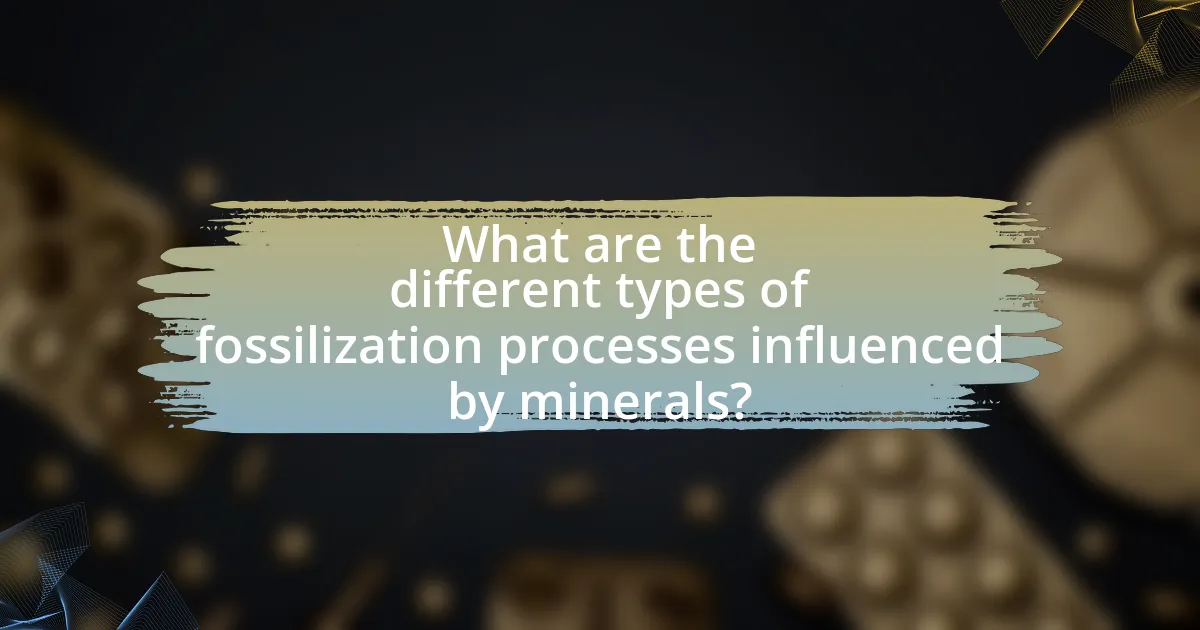
What are the different types of fossilization processes influenced by minerals?
The different types of fossilization processes influenced by minerals include permineralization, replacement, and authigenic mineralization. Permineralization occurs when minerals fill the pores and cavities of organic material, preserving its structure, as seen in many dinosaur bones where silica or calcite infiltrates the bone matrix. Replacement involves the gradual substitution of the original organic material with minerals, such as when wood is replaced by silica, resulting in petrified wood. Authigenic mineralization happens when minerals precipitate from surrounding water and form around organic remains, often seen in the formation of fossils in sedimentary rocks. These processes demonstrate how mineral composition directly affects the preservation and formation of fossils.
How does permineralization occur and what minerals are involved?
Permineralization occurs when mineral-rich water permeates the porous structures of organic remains, leading to the deposition of minerals within those structures. This process typically involves minerals such as silica, calcite, and pyrite, which replace organic material or fill voids in the remains, preserving their shape and structure. The presence of these minerals is crucial, as they contribute to the fossilization process by enhancing the durability and longevity of the preserved remains, allowing them to withstand geological processes over time.
What are the steps in the permineralization process?
The steps in the permineralization process include the infiltration of mineral-rich water into organic material, the deposition of minerals within the cellular structure, and the gradual replacement of organic material with minerals. Initially, when an organism dies, its remains are buried under sediment, which allows mineral-laden water to permeate the tissues. As the water moves through the remains, minerals such as silica, calcite, or iron are deposited in the empty spaces of the organic material. Over time, this process leads to the replacement of the original organic material, resulting in a fossil that retains the structure of the original organism while being composed primarily of minerals. This process is crucial for fossilization, as it preserves the details of the organism’s structure, allowing for study and analysis by paleontologists.
Which minerals are most effective in permineralization?
The minerals most effective in permineralization are silica, calcite, and pyrite. Silica, often in the form of quartz, replaces organic material and preserves fine details in fossils. Calcite, a common mineral in sedimentary rocks, can fill voids in bones and shells, enhancing fossilization. Pyrite, or fool’s gold, can also replace organic material, creating detailed fossil replicas. These minerals contribute significantly to the fossilization process by providing the necessary conditions for the preservation of biological structures over geological time.
What is the role of mineral replacement in fossilization?
Mineral replacement plays a crucial role in fossilization by allowing organic materials to be gradually replaced with minerals, preserving the original structure of the organism. This process, known as permineralization, occurs when minerals such as silica, calcite, or pyrite infiltrate the porous spaces of the organic remains, effectively turning them into stone over time. Evidence of this process can be observed in fossilized wood, where the original cellulose structure is replaced by silica, resulting in petrified wood that retains the original shape and details of the plant.
How does mineral replacement differ from other fossilization methods?
Mineral replacement differs from other fossilization methods by specifically involving the gradual substitution of organic material with minerals, preserving the original structure in detail. In contrast, methods like permineralization involve the filling of pores with minerals without replacing the original material, while carbonization reduces organic material to a carbon film, losing much of the original structure. Mineral replacement allows for a more accurate representation of the organism’s morphology, as seen in fossils like petrified wood, where the original wood structure is maintained while being replaced by silica. This process highlights the role of mineral composition in fossilization, emphasizing how different methods yield varying levels of detail and preservation.
What minerals are commonly used in the replacement process?
Silica, calcite, and pyrite are commonly used in the replacement process during fossilization. These minerals replace organic material in fossils, preserving their structure. For instance, silica can replace the original organic material in plants and animals, resulting in petrified wood or siliceous fossils. Calcite often replaces calcium carbonate structures, while pyrite can form when organic matter is buried in anoxic conditions, leading to pyritization. These processes demonstrate how mineral composition directly influences fossilization outcomes.
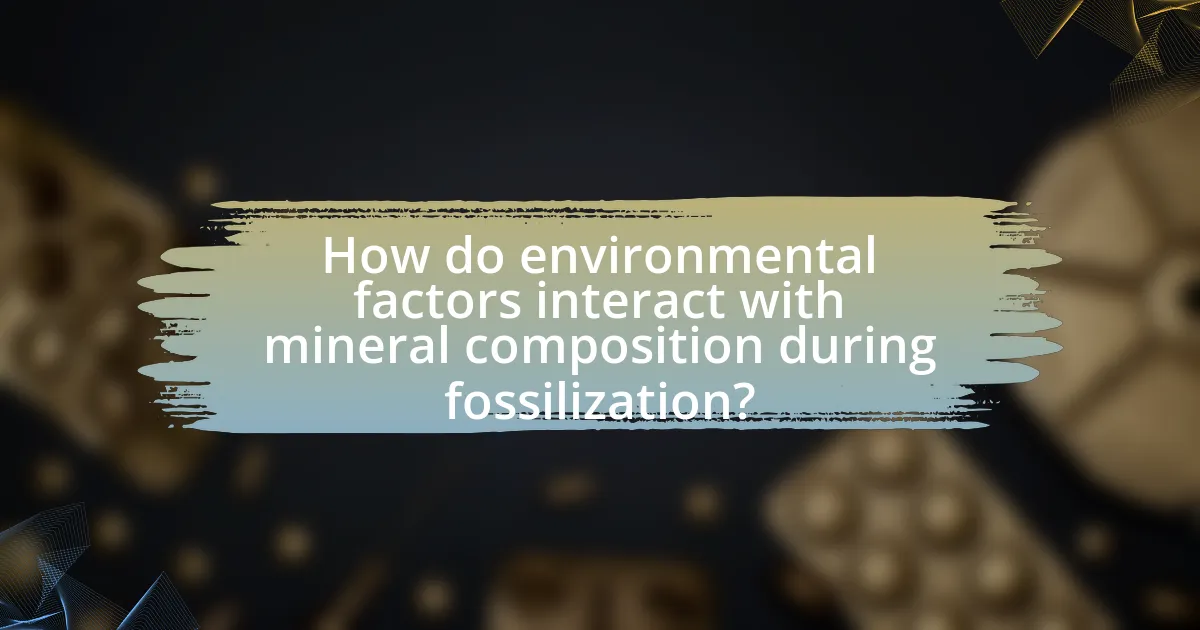
How do environmental factors interact with mineral composition during fossilization?
Environmental factors significantly influence mineral composition during fossilization by determining the conditions under which organic materials are preserved and transformed into fossils. For instance, the presence of water, temperature, and sediment type affects the rate of mineralization, as well as the specific minerals that replace organic tissues. In aquatic environments, minerals such as silica and calcium carbonate often precipitate from water, facilitating the replacement of organic material with these minerals, which leads to the formation of fossils. Research indicates that variations in pH and salinity can also alter mineral composition, impacting the fossilization process. For example, acidic conditions may favor the dissolution of certain minerals, while alkaline conditions can enhance the preservation of calcium-based fossils. Thus, the interplay between environmental factors and mineral composition is crucial for understanding the fossilization process.
What environmental conditions favor specific mineral compositions in fossils?
Specific environmental conditions that favor particular mineral compositions in fossils include the chemical composition of the surrounding sediment, the pH level of the environment, and the temperature and pressure conditions during burial. For instance, high calcium carbonate concentrations in marine environments often lead to fossils with calcite or aragonite mineralization, while siliceous environments can result in fossils composed of opal or quartz. Additionally, acidic conditions can promote the dissolution of original skeletal materials, leading to the precipitation of minerals like pyrite or hematite. These relationships are supported by studies showing that the mineralogy of fossils directly correlates with the depositional environment and diagenetic processes, as evidenced by fossil records from various geological settings.
How do temperature and pressure influence mineral formation in fossils?
Temperature and pressure significantly influence mineral formation in fossils by affecting the chemical reactions and physical processes involved in mineralization. Higher temperatures can accelerate the rate of chemical reactions, leading to the faster precipitation of minerals from surrounding fluids, while increased pressure can enhance the solubility of minerals, allowing for more efficient mineral replacement in fossilized remains. For example, during the process of diagenesis, which occurs at elevated temperatures and pressures, minerals such as calcite and quartz can replace organic materials in fossils, resulting in the preservation of their structure. This relationship is supported by geological studies that demonstrate how varying conditions of temperature and pressure in sedimentary environments directly correlate with the types of minerals found in fossilized remains.
What role does sediment type play in mineral composition during fossilization?
Sediment type significantly influences mineral composition during fossilization by determining the chemical environment and the minerals available for replacement. Different sediment types, such as clay, sand, or limestone, provide varying mineralogical contexts that affect the preservation of organic material. For instance, fine-grained sediments like clay can facilitate the preservation of delicate structures due to their ability to inhibit decay and promote mineralization through slow chemical processes. In contrast, coarser sediments may lead to faster decomposition and less favorable conditions for fossilization. Studies have shown that the mineral composition of the surrounding sediment can dictate the types of minerals that replace organic material, with silica and calcium carbonate being common in many fossilization processes.
How can changes in mineral composition affect fossil integrity over time?
Changes in mineral composition can significantly affect fossil integrity over time by altering the physical and chemical properties of the fossilized remains. When minerals in the surrounding sediment or groundwater change, they can replace original organic materials through a process called permineralization, which can enhance or compromise the structural integrity of the fossil. For example, the replacement of calcium carbonate with silica can lead to increased durability, while the introduction of more soluble minerals can result in the dissolution of original structures, leading to loss of detail and fragility. Studies have shown that fossils with higher mineral content tend to preserve better over geological timescales, as evidenced by the well-preserved fossils found in mineral-rich environments compared to those in less mineralized settings.
What are the effects of diagenesis on fossilized minerals?
Diagenesis significantly alters fossilized minerals through processes such as compaction, cementation, and mineral replacement. These processes can lead to changes in the mineralogy and texture of the fossils, affecting their preservation and the information they provide about past environments. For instance, during diagenesis, original minerals may dissolve and be replaced by more stable minerals like calcite or quartz, which can enhance the durability of the fossils. Additionally, the compaction of sediments can lead to increased pressure, which may cause the reorganization of mineral grains and the formation of new mineral phases. These transformations are crucial for understanding the geological history and paleoenvironmental conditions in which the fossils were formed.
How does mineral leaching impact fossil preservation?
Mineral leaching negatively impacts fossil preservation by removing essential minerals that contribute to the structural integrity of fossils. When minerals are leached from the surrounding sediment, the fossil may become more susceptible to degradation and loss of detail. For instance, studies have shown that leaching can lead to the dissolution of calcium carbonate in shells, resulting in incomplete or poorly preserved specimens. This process can significantly hinder the ability to study and understand the original biological and ecological characteristics of the organisms involved.
What practical methods can be used to analyze mineral composition in fossils?
Practical methods to analyze mineral composition in fossils include X-ray diffraction (XRD), scanning electron microscopy (SEM), and energy-dispersive X-ray spectroscopy (EDX). XRD identifies crystalline phases and mineral content by measuring the diffraction patterns of X-rays interacting with the fossil’s minerals. SEM provides high-resolution images and surface morphology, allowing for detailed observation of mineral structures. EDX, often coupled with SEM, quantifies elemental composition by detecting X-rays emitted from the sample when it is bombarded with electrons. These methods are widely used in paleontology and geology to understand the mineralogical changes that occur during fossilization, providing insights into the environmental conditions at the time of fossil formation.
What techniques are commonly employed in mineral analysis of fossils?
Common techniques employed in mineral analysis of fossils include X-ray diffraction (XRD), scanning electron microscopy (SEM), and energy-dispersive X-ray spectroscopy (EDX). XRD is utilized to identify the mineralogical composition by analyzing the diffraction patterns of X-rays scattered by the crystalline structures in the fossil. SEM provides high-resolution images of the fossil’s surface morphology and can be coupled with EDX to determine elemental composition at micro-scale levels. These methods are validated by their widespread application in paleontology and geology, demonstrating their effectiveness in revealing the mineral content and preservation conditions of fossils.
How can these methods improve our understanding of fossilization processes?
These methods can enhance our understanding of fossilization processes by providing insights into the mineral composition and environmental conditions that influence fossil preservation. For instance, advanced imaging techniques, such as X-ray computed tomography, allow researchers to visualize the internal structures of fossils without damaging them, revealing how mineralization occurs at a microscopic level. Studies have shown that the presence of specific minerals, like silica and calcium carbonate, significantly affects the durability and longevity of fossils, as evidenced by the fossilization of marine organisms in sedimentary environments rich in these minerals. By analyzing the mineralogical composition of fossilized remains, scientists can better reconstruct the conditions under which these organisms were preserved, leading to a more comprehensive understanding of the fossilization process.

